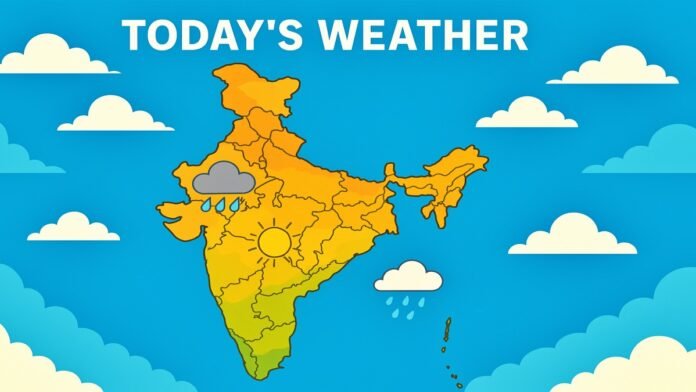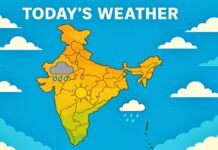
Key Points
- The India Meteorological Department confirms Cyclone Montha will intensify into a severe cyclonic storm by October 27-28, making landfall near Kakinada, Andhra Pradesh, with wind speeds reaching 110 kmph, prompting red alerts in Andhra Pradesh and Odisha and mobilization of NDRF and ODRF disaster response teams.
- Delhi’s Air Quality Index plunged to 322 on October 26, 2025, entering the “Very Poor” category, with Anand Vihar recording a dangerous 430 AQI in the “Severe” range as post-Diwali pollution compounds with seasonal factors, triggering Stage II of the Graded Response Action Plan.
- The approaching cyclone threatens to disrupt Chhath Puja celebrations on October 27-28, particularly affecting the critical Sandhya Arghya and Usha Arghya rituals in Uttar Pradesh, Bihar, and Jharkhand, with the IMD forecasting moderate to heavy rainfall during peak observance days.
- Two distinct weather systems, a depression in the east-central Arabian Sea and the intensifying Bay of Bengal cyclone, are generating widespread rainfall across southern and eastern India, with Tamil Nadu, Kerala, Karnataka, and Andhra Pradesh receiving more than twice their normal October rainfall since the northeast monsoon’s early onset on October 16.
- Coastal Maharashtra, including Mumbai, faces heavy rainfall alerts for October 28-29, while the northeast monsoon continues delivering surplus precipitation to peninsular India, with Tamil Nadu receiving 134mm, Andhra Pradesh 123mm, and Kerala 164mm in the first nine days following monsoon onset.
New Delhi: India finds itself grappling with an unprecedented convergence of meteorological challenges as October 2025 draws to a close, with a potentially devastating cyclone threatening the eastern seaboard, toxic air pollution choking the national capital, and multiple weather systems disrupting normal life across vast stretches of the subcontinent. The India Meteorological Department has activated emergency protocols across multiple states, warning of severe impacts that could affect hundreds of millions of citizens during the ongoing festival season.
The most immediate threat comes from Cyclone Montha, a rapidly intensifying weather system in the Bay of Bengal that meteorologists predict will make landfall along the Andhra Pradesh coast within the next 48-72 hours. Simultaneously, Delhi-NCR residents face dangerous air quality conditions following Diwali celebrations, while sacred Chhath Puja observances scheduled for October 27-28 hang in the balance as rain forecasts threaten to disrupt critical rituals performed by millions of devotees across North India.
Cyclone Montha: Eastern India on Maximum Alert
According to the latest bulletin issued by the India Meteorological Department at 5:30 PM IST on October 25, a low-pressure area that formed over the southeast Bay of Bengal has been moving west-northwestward and intensifying with alarming rapidity. The system strengthened into a depression on October 25 and is forecast to evolve into a deep depression by October 26, before transforming into a full-fledged cyclonic storm over the southwest and adjoining west-central Bay of Bengal by October 27.
Current projections indicate that Cyclone Montha will make landfall along the Andhra Pradesh coast near the port city of Kakinada on the evening or night of October 28, packing maximum sustained wind speeds of approximately 110 kilometers per hour with gusts potentially reaching 120 kmph. Dr. Manorama Mohanty, Director of the Bhubaneswar Meteorological Center, confirmed the system’s rapid intensification trajectory, stating that the depression south of the Bay of Bengal is strengthening faster than initially anticipated.
The cyclone’s anticipated path threatens a densely populated coastal corridor stretching from southern Odisha through Andhra Pradesh into northern Tamil Nadu. The IMD has issued red alerts, its highest warning level, for multiple districts in both Andhra Pradesh and Odisha for October 27-29, with particular emphasis on coastal and south coastal regions expected to bear the brunt of the storm’s fury.
Rainfall predictions paint a dire picture of the storm’s potential impact. The meteorological department forecasts light to moderate rainfall at most places across coastal Andhra Pradesh, Rayalaseema, Odisha, and parts of West Bengal, with isolated areas experiencing very heavy to extremely heavy precipitation exceeding 21 centimeters during the October 27-29 window. South coastal Andhra Pradesh and Rayalaseema face the highest risk of catastrophic rainfall during this critical period.
Government Mobilization and Disaster Preparedness
Andhra Pradesh Chief Minister N. Chandrababu Naidu has declared a comprehensive red alert spanning October 26-29, directing all district administrations and disaster management officials to implement maximum preparedness protocols aimed at preventing loss of life and property. The state government has activated its entire emergency response machinery, with control rooms operating around the clock to coordinate evacuation and relief efforts.
In neighboring Odisha, which bears the scars of previous devastating cyclones, including the catastrophic 1999 super cyclone that claimed over 10,000 lives, authorities have activated their internationally recognized disaster preparedness model. Revenue and Disaster Management Minister Suresh Pujari confirmed that National Disaster Response Force (NDRF) and Odisha Disaster Rapid Action Force (ODRAF) teams have been positioned at strategic locations along the coast, with additional units on standby for rapid deployment.
State authorities have issued strict advisories prohibiting fishing vessels from venturing into the Bay of Bengal from October 26-29, with those already at sea ordered to return to port immediately. The IMD has warned that squally weather with wind speeds of 40-50 kmph gusting to 60 kmph will prevail over the southwest and central Bay of Bengal, along with the Tamil Nadu-Andhra Pradesh coasts throughout this period.
While current forecasts suggest Cyclone Montha may not make a direct landfall in Odisha, unlike Cyclone Dana, which struck the state’s coast near Bhitarkanika in late October 2024 with similar intensity, officials are taking no chances, given the storm’s projected proximity and the potential for last-minute track changes. Cyclone Dana, which made landfall on October 24-25, 2024, forced the evacuation of over 1.1 million people and caused extensive damage to infrastructure, trees, and power lines across Odisha and West Bengal, serving as a sobering recent reminder of the Bay of Bengal’s destructive potential.
Delhi-NCR Suffocates Under Toxic Air Blanket
While eastern India braces for cyclonic fury, the national capital region confronts an entirely different yet equally serious environmental emergency. Delhi’s Air Quality Index plummeted to a dangerous 318 on Sunday morning, October 26, firmly placing the city in the “Very Poor” category and marking a sharp deterioration from the “Poor” readings of 257 recorded on Saturday morning and 293 on Friday.
According to data from the Central Pollution Control Board, several monitoring stations across Delhi-NCR recorded alarming pollution levels on Sunday morning. Anand Vihar, a perennial pollution hotspot in east Delhi, registered a catastrophic AQI of 430 well into the “Severe” category that poses serious health risks even to healthy individuals and can be life-threatening for those with pre-existing respiratory or cardiovascular conditions. Other heavily polluted locations include Bawana at 390, Burari Crossing at 344, Patparganj at 339, and the ITO area at 329.
The Air Quality Early Warning System for Delhi, operated by the Ministry of Earth Sciences, projects that pollution levels could climb even higher, potentially crossing the 340 mark in the coming days as meteorological conditions remain unfavorable for pollutant dispersion. The toxic haze that blanketed the city on Sunday morning significantly reduced visibility across large swathes of the metropolitan area, creating hazardous conditions for commuters and outdoor activities.
The pollution spike follows the Diwali festival celebrations, during which widespread firecracker bursting despite official bans contributed to a sharp increase in particulate matter concentrations. However, experts note that the post-Diwali pollution surge represents just one component of a complex seasonal phenomenon driven by multiple factors, including stubble burning in neighboring agricultural states, vehicular emissions, construction dust, industrial pollution, and unfavorable meteorological conditions that trap pollutants close to ground level.
Healthcare facilities across Delhi-NCR have reported a marked increase in patients presenting with respiratory ailments, breathing difficulties, and pregnancy-related complications exacerbated by poor air quality. The pollution crisis poses particular risks to vulnerable populations, including children, elderly citizens, pregnant women, and individuals with asthma, chronic obstructive pulmonary disease, and cardiac conditions.
Municipal authorities have deployed truck-mounted water sprinklers across the city in an effort to suppress dust particles and provide marginal relief from the toxic air. Stage II of the Graded Response Action Plan (GRAP-2) remains in effect across the National Capital Region, imposing restrictions on construction activities, diesel generator usage, and other pollution-generating activities.
Chhath Puja Under Cyclone’s Shadow
The approaching cyclonic system has cast a cloud of uncertainty over one of North India’s most sacred and widely observed festivals. Chhath Puja, which began on October 25 with the Nahay Khay ritual, faces potential severe disruption during its most critical observance days of October 27-28, when devotees perform the Sandhya Arghya (evening offering) and Usha Arghya (morning offering) to the Sun God while standing in rivers, ponds, and other water bodies.
The IMD has issued a specific weather alert for eastern Uttar Pradesh covering the next four days beginning October 27, warning of rainfall that could significantly impact Chhath celebrations in this heartland region where millions participate in the elaborate rituals. While the core Chhath-observing states of Bihar, Jharkhand, and eastern Uttar Pradesh are not expected to experience a direct cyclonic hit, meteorologists warn that the outer bands of Cyclone Montha will bring moderate to heavy rainfall and thunderstorms precisely during the October 27-28 peak festival period.
Weather experts note that while western Uttar Pradesh is forecast to remain largely dry, the eastern districts, which host some of the largest concentrations of Chhath devotees along the banks of the Ganges, Yamuna, and other rivers, face the highest probability of rain-related disruptions. The prospect of standing in water bodies during thunderstorms with lightning and strong winds poses obvious safety concerns beyond the mere inconvenience of interrupted rituals.
Community organizers and local administrations are closely monitoring weather updates and preparing contingency plans, though the deeply traditional and religiously significant nature of Chhath Puja makes it difficult to postpone or relocate the time-sensitive solar offerings. The potential for weather-related disruption to such an important festival adds a cultural and emotional dimension to the cyclone’s anticipated impact that extends far beyond purely material considerations.
Northeast Monsoon Delivers Surplus Rainfall to South India
Adding to India’s complex meteorological situation, the northeast monsoon, which officially commenced on October 16, four days ahead of the normal onset date of October 22, has been delivering significantly above-normal rainfall across peninsular India. This marks the second consecutive year of early monsoon onset for the region, reflecting broader patterns of climate variability affecting seasonal weather systems.
In the nine days from October 16-24 following the monsoon’s declaration, Tamil Nadu received 134 millimeters of rainfall, Andhra Pradesh 123mm, Kerala 164mm, and Karnataka 73mm, all representing more than double their respective long-period averages for this timeframe. Andhra Pradesh recorded the largest deviation, receiving 2.6 times its normal rainfall, while Kerala’s surplus stood at 2.1 times the historical average despite having the highest absolute precipitation.
The torrential rainfall has made this late-October period one of the wettest in peninsular India in the past 125 years, according to an analysis of the IMD’s comprehensive gridded rainfall data. Light to moderate rain or thunderstorms continue at most places across Tamil Nadu, Kerala, Mahe, coastal and south interior Karnataka, coastal Andhra Pradesh, Rayalaseema, and Telangana, with isolated heavy rainfall forecast to persist through October 30.
The northeast monsoon, which typically extends from October through December, differs fundamentally from the more widely known southwest monsoon that dominates India’s summer rainy season. While the southwest monsoon brings moisture-laden winds from the Arabian Sea across most of India, the northeast monsoon draws its precipitation from easterly and northeasterly winds blowing across the Bay of Bengal, primarily affecting the eastern coast of peninsular India.
However, IMD’s long-range forecasts suggest that the current large surplus in rainfall may not translate into an overall excess for the entire October-December northeast monsoon season, with predictions indicating a possible dry spell in November that could partially offset the early abundance. This pattern of intense early-season rainfall followed by relative dryness reflects the increasing variability and unpredictability affecting India’s monsoon systems in recent years.
Dual Pressure Systems Create Multi-Regional Impact
Meteorological analysis reveals that India currently faces the simultaneous influence of two distinct low-pressure systems operating in different oceanic basins. Beyond the well-documented Bay of Bengal depression that is evolving into Cyclone Montha, a separate weather system remains active over the east-central Arabian Sea, contributing to rainfall across western coastal regions.
The Arabian Sea system is generating squally weather conditions with wind speeds of 40-50 kmph gusting to 60 kmph over the central Arabian Sea, particularly affecting maritime activities in this region through October 26. While this western system lacks the intensity and landfall potential of its Bay of Bengal counterpart, it contributes to the overall pattern of enhanced rainfall activity across multiple regions simultaneously.
Coastal Maharashtra, particularly the Mumbai metropolitan region, faces its own rainfall challenges with the IMD issuing alerts for heavy precipitation on October 28-29. Light to moderate rain is forecast across the Konkan and Goa regions, with the possibility of isolated heavy rainfall at multiple locations during this window. Southeastern Rajasthan may also experience light rainfall, expanding the geographic footprint of weather conditions across western India.
This dual-system configuration creates a complex meteorological scenario where different regions face distinct weather-related challenges simultaneously, stretching the capacity of disaster management and meteorological monitoring infrastructure across multiple states. The interaction between these systems, combined with the active northeast monsoon and seasonal transition patterns, generates an unusually volatile atmospheric environment conducive to extreme weather events.
Western Disturbance to Impact the Himalayan Region
Adding yet another layer to India’s meteorological complexity, a fresh western disturbance is forecast to affect the western Himalayan region beginning October 27, bringing light to moderate precipitation over northwestern parts of the country. These mid-latitude weather systems, which originate over the Mediterranean Sea and travel eastward, play a crucial role in bringing winter precipitation to India’s northern mountain regions.
The incoming western disturbance is expected to generate light rain or drizzle primarily during the evening of October 27 through the morning of October 28 across Jammu and Kashmir, Himachal Pradesh, and Uttarakhand. While the anticipated precipitation remains relatively modest compared to the intense rainfall expected in eastern and southern India, it contributes to the overall pattern of widespread weather activity spanning nearly the entire subcontinent.
For Delhi-NCR and the broader Indo-Gangetic Plain, the western disturbance may bring marginal changes to wind patterns and temperature profiles, though its direct precipitation impact is expected to remain limited. The national capital region faces mainly clear skies with morning mist or haze, maximum temperatures between 30-32°C, and minimum temperatures ranging from 16-18°C, with light winds shifting from northwest in morning hours to northeast during afternoon and evening.
Regional Weather Outlook Through Month-End
As India navigates the final week of October 2025, the meteorological situation across different regions presents a complex mosaic of weather challenges. Eastern India, encompassing Odisha, West Bengal, Jharkhand, and Bihar, faces the most severe immediate threat from Cyclone Montha, with disaster management protocols activated and millions of residents preparing for potential evacuations and infrastructure damage.
Southern peninsular states continue experiencing persistent rainfall under the influence of the active northeast monsoon and the approaching cyclonic system, with Tamil Nadu, Kerala, Karnataka, and Andhra Pradesh expecting continued wet conditions through at least October 30. The combination of monsoon rainfall and cyclone-induced precipitation creates flooding risks in coastal and low-lying areas, particularly in districts with already saturated soil conditions from weeks of above-normal rainfall.
North India presents a bifurcated picture, with the Indo-Gangetic Plain grappling with pollution and relatively dry conditions punctuated by morning fog and mist, while the Himalayan regions anticipate light precipitation from the incoming western disturbance. The contrast between the choking pollution in Delhi and the approaching cyclone in Odisha underscores the diverse environmental challenges confronting different parts of the country simultaneously.
Western coastal regions, including Maharashtra’s Konkan belt and Goa, remain on alert for heavy rainfall during October 28-29, requiring continued monitoring and preparedness measures even as attention focuses primarily on the eastern cyclone threat. The Gujarat coast faces squally conditions from the Arabian Sea system, though with significantly less intensity than the Bay of Bengal disturbance.
Climate Variability and Seasonal Transition
The current meteorological situation reflects the complex dynamics of India’s seasonal transition period, when the retreating southwest monsoon gives way to the advancing northeast monsoon while post-monsoon cyclogenesis peaks in the Bay of Bengal. October historically represents one of the most active months for tropical cyclone formation in the North Indian Ocean basin, with warm sea surface temperatures and favorable atmospheric conditions supporting rapid storm development.
The early onset of the northeast monsoon on October 16, following a similar early arrival in 2024, suggests potential shifts in the timing and characteristics of this seasonal weather pattern. Climate scientists have noted increasing variability in monsoon onset dates, intensity patterns, and rainfall distribution in recent decades, complicating forecasting efforts and agricultural planning across the affected regions.
The simultaneous occurrence of multiple weather phenomena, cyclone development, active monsoon rainfall, western disturbances, and severe pollution episodes while not unprecedented, highlights the challenges facing meteorological services and disaster management authorities in a country as geographically vast and climatically diverse as India. The convergence of these systems during the ongoing festival season adds urgency to response efforts and magnifies potential socioeconomic impacts.
As Cyclone Montha continues its inexorable march toward the Andhra Pradesh coast, millions of Indian citizens across multiple states brace for a weekend of severe weather, disrupted celebrations, and heightened anxiety about the safety of coastal communities in the storm’s anticipated path. The coming 48-72 hours will prove critical in determining the full extent of the cyclone’s impact and testing the resilience of India’s disaster preparedness infrastructure developed through hard-won lessons from previous catastrophic storms.

















































